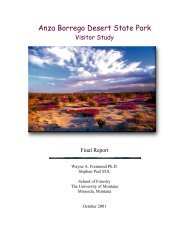Final Mitigated Negative Declaration and Response to Comments
Final Mitigated Negative Declaration and Response to Comments
Final Mitigated Negative Declaration and Response to Comments
You also want an ePaper? Increase the reach of your titles
YUMPU automatically turns print PDFs into web optimized ePapers that Google loves.
XII. NOISE.<br />
ENVIRONMENTAL SETTING<br />
The project area is located in Emerald Bay State Park (SP) in the Lake Tahoe Basin. Activities<br />
would be conducted from a boat or barge <strong>and</strong> work would occur in the underwater portion of<br />
the park. This area is characterized by a natural setting which is often free of loud noise;<br />
however, boat traffic can be very heavy at times in this area <strong>and</strong> noise can travel great<br />
distances over the flat lake surface.<br />
Sound is any detectable fluctuation in air pressure <strong>and</strong> generally is measured on a logarithmic<br />
scale in decibels (dB). When unwanted sound (i.e., noise) is measured, an electronic filter is<br />
used <strong>to</strong> de-emphasize extreme high <strong>and</strong> low frequencies <strong>to</strong> which human hearing has<br />
decreased sensitivity. Resulting noise measurements are expressed in weighting frequencies<br />
called A-weighted decibels (dBA). While zero dBA is the low threshold of human hearing, a<br />
sustained noise equal or greater than 90 dBA is painful <strong>and</strong> can cause hearing loss (Table XI-<br />
1, Bearden 2000).<br />
Table XI-1: Sound Levels Generated by Various Sources of Noise<br />
Sound Level<br />
dBA<br />
Quiet library, soft whispers 30<br />
Living room, refrigera<strong>to</strong>r 40<br />
Light traffic, normal conversation, quiet office 50<br />
Air conditioner at 20 feet, sewing machine 60<br />
Vacuum cleaner, hair dryer, noisy restaurant 70<br />
Average city traffic, garbage disposals, alarm clock at 2 feet 80<br />
Constant exposure <strong>to</strong> the following sound levels can lead <strong>to</strong> hearing loss<br />
Subway, mo<strong>to</strong>rcycle, truck traffic, lawn mower 90<br />
Garbage truck, chain saw, pneumatic drill 100<br />
Rock b<strong>and</strong> concert in front of speakers, thunderclap 120<br />
Gunshot blast, jet plane 140<br />
Rocket launching pad 180<br />
(Bearden 2000)<br />
Noise is further described according <strong>to</strong> how it varies over time <strong>and</strong> whether the source of noise<br />
is moving or stationary. Background noise in a particular location gradually varies over the<br />
course of a 24-hour period with the addition <strong>and</strong> elimination of individual sounds. Several<br />
terms are used <strong>to</strong> describe noise <strong>and</strong> its effects. The equivalent sound level (L eq ) describes<br />
the average noise exposure level for a specific location during a specific time period, typically<br />
over the course of one hour. The Community Noise Equivalent Level (CNEL) is a twenty-four<br />
hour average of L eq with an additional 5 dBA penalty for noise generated between the hours of<br />
7:00 p.m. <strong>and</strong> 10:00 p.m. <strong>and</strong> a 10 dBA penalty during the hours of 10:00 p.m. <strong>and</strong> 7:00 a.m.<br />
The penalties account for how much more pronounced a noise is at night when other sounds<br />
have diminished. Federal, state, <strong>and</strong> local governments have defined noise <strong>and</strong> established<br />
Asian Clam Control Project IS/MND<br />
Emerald Bay State Park<br />
California Department of Parks <strong>and</strong> Recreation<br />
59
















